The struggling eurozone manufacturing sector began showing signs of stabilizing as companies grew more optimistic, despite escalating costs and potential U.S. tariffs, according to a recent survey.
The final eurozone manufacturing Purchasing Managers’ Index from HCOB, compiled by S&P Global, rose to 46.6 in January, a higher figure compared to the preliminary 46.1 forecast and edging closer to the 50 threshold that distinguishes between expansion and contraction.
The index has been below 50 since mid-2022 and fell to 45.1 in December.
The output index, deemed an insightful indicator of economic health and a component of the composite PMI, increased to 47.1 from December’s 44.3.
Cyrus de la Rubia, chief economist at Hamburg Commercial Bank, suggested that while it’s premature to call it a recovery, the rising PMI indicates a move towards stabilization, halting a two-month recession deepening.
Meanwhile, President Donald Trump’s proposed 10% tariff on imports from the euro zone’s 20-member currency union could make European products pricier in the U.S., potentially decreasing demand.
However, the longstanding decline in demand saw some relief as the new orders index climbed to a peak not seen in eight months, rising to 45.4 from 43.0.
The European Central Bank (ECB) reduced interest rates last Thursday and hinted at another possible cut in March. This move aims to lower business borrowing costs and expand consumer disposable income.
Despite ongoing workforce reductions, companies’ outlook for the coming year surged to its most optimistic level in nearly three years, surpassing the long-term average. The analyst pointed out a notable increase in future confidence, hinting that there may be signs of an end to the economic drag.





